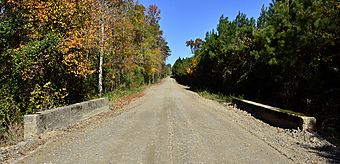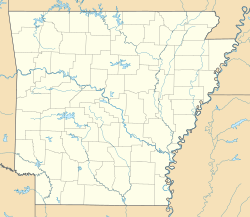Dollarway Road facts for kids
|
Dollarway Road
|
|

The Dollarway Road in 2013
|
|
| Location | Redfield, Arkansas |
|---|---|
| Area | 12.5 acres (5.1 ha) (after increase) |
| Built | 1913 |
| Architect | Shelby, Isaac Prather |
| NRHP reference No. | 74000480 (original) 99000822 (increase) |
Quick facts for kids Significant dates |
|
| Added to NRHP | May 17, 1974 |
| Boundary increase | July 15, 1999 |
The Dollarway Road is a special old road in Redfield, Arkansas. It was built a long time ago, in 1913. This road is so important that it was added to the National Register of Historic Places in 1974.
Contents
Building a Better Road
At the start of the 1900s, people in the United States wanted better roads. Back then, Arkansas didn't have a state group to build highways. Instead, local areas called "road districts" were in charge. These districts were often made up of farmers and local people. They didn't always have much experience in building roads.
One of these groups, Jefferson County Road Improvement District No. 4, decided to build a concrete road. It would go from Pine Bluff, Arkansas, north to the Jefferson County line. This was a big project for its time.
How the Dollarway Road Was Built
The Dollarway Road was made using concrete slabs. Each slab was about 9 feet (2.7 m) wide. The concrete was a special mix. On top of the concrete, a thin layer of coal tar was added. This layer was only about 1/16 inch thick.
The edges of the road sloped down at a 45-degree angle. This meant that only about 8.5 feet (2.6 m) of the road was flat. The sloped edges acted like curbs. Next to the main road, there was a gravel shoulder about 18 inches (0.46 m) wide. Beyond that, there was 3 feet (0.91 m) of earthwork. The gravel shoulder was helpful because cars could pull over onto it. This allowed other cars to pass, which was important when roads were narrower.
Why the Name "Dollarway"?
People often say the road was called "Dollarway" because it cost one dollar for every foot of road built. However, the actual cost was a bit more, closer to $1.36 per foot.
In July 1913, contractors named Shelby and Bateman from Little Rock, Arkansas were chosen. They built the road, which was about 23 miles long. Construction started in November 1913. The road was finished in October 1914. When it was completed, the Dollarway Road was the longest continuous concrete road in the United States.
Road Durability
Even though the road was well-built, it needed care. People found that the tar layer on top had to be replaced often. Sometimes it needed new tar every year or two. If the tar peeled off, the concrete underneath could start to break apart. This meant that parts of the road had to be fixed or replaced. It showed that even good roads need regular maintenance to last a long time.
The Dollarway Road Today
When the Dollarway Road was first added to the National Register of Historic Places in 1974, only a small part of it was included. This part was in a park near Redfield.
Later, in 1999, the protected area was made larger. It now includes a section of the Dollarway Road that people still use today. This part is known as Reynolds Road. This section also has two original concrete bridges from the Dollarway Road.



